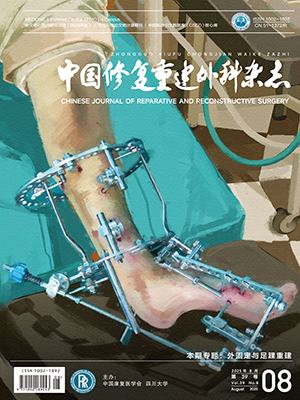| 1. |
Stowers MD, Manuopangai L, Hill AG, et al. Enhanced Recovery After Surgery in elective hip and knee arthroplasty reduces length of hospital stay. ANZ J Surg, 2016, 86(6): 475-479.
|
| 2. |
Myles P, Bellomo R, Corcoran T, et al. Restrictive versus liberal fluid therapy in major abdominal surgery (RELIEF): rationale and design for a multicentre randomised trial. BMJ Open, 2017, 7(3): e015358.
|
| 3. |
Schol PB, Terink IM, Lancė MD, et al. Liberal or restrictive fluid management during elective surgery: a systematic review and meta-analysis. J Clin Anesth, 2016, 35(1): 26-39.
|
| 4. |
Hollman F, Wolterbeek N, Veen R. Risk Factors for Postoperative Urinary Retention in Men Undergoing Total Hip Arthroplasty. Orthopedics, 2015, 38(6): e507-511.
|
| 5. |
Fernandez MA, Karthikeyan S, Wyse M, et al. The incidence of postoperative urinary retention in patients undergoing elective hip and knee arthroplasty. Ann R Coll Surg Engl, 2014, 96(6): 462-465.
|
| 6. |
Bjerregaard LS, Bogø S, Raaschou S, et al. Incidence of and risk factors for postoperative urinary retention in fast-track hip and knee arthroplasty. Acta Orthop, 2015, 86(2): 183-188.
|
| 7. |
Xie JW, Ma J, Yao H, et al. Multiple Boluses of Intravenous Tranexamic Acid to Reduce Hidden Blood Loss After Primary Total Knee Arthroplasty Without Tourniquet: A Randomized Clinical Trial. J Arthroplasty, 2016, 31(11): 2458-2464.
|
| 8. |
Pang Q, Liu H, Chen B, et al. Restrictive and liberal fluid administration in major abdominal surgery. Saudi Med J, 2017, 38(2): 123-131.
|
| 9. |
Miller TE, Roche AM, Mythen M. Fluid management and goal-directed therapy as an adjunct to Enhanced Recovery After Surgery (ERAS). Can J Anaesth, 2015, 62(2): 158-168.
|
| 10. |
Nisanevich V, Felsenstein I, Almogy G, et al. Effect of intraoperative fluid management on outcome after intraabdominal surgery. Anesthesiology, 2005, 103(1): 25-32.
|
| 11. |
González-Fajardo JA, Mengibar L, Brizuela JA, et al. Effect of postoperative restrictive fluid therapy in the recovery of patients with abdominal vascular surgery. Eur J Vasc Endovasc Surg, 2009, 37(5): 538-543.
|
| 12. |
Chatrath V, Khetarpal R, Ahuja J. Fluid management in patients with trauma: Restrictive versus liberal approach. J Anaesthesiol Clin Pharmacol, 2015, 31(3): 308-316.
|
| 13. |
Duke MD, Guidry C, Guice J, et al. Restrictive fluid resuscitation in combination with damage control resuscitation: time for adaptation. J Trauma Acute Care Surg, 2012, 73(3): 674-678.
|
| 14. |
Boland MR, Noorani A, Varty K, et al. Perioperative fluid restriction in major abdominal surgery: systematic review and meta-analysis of randomized, clinical trials. World J Surg, 2013, 37(6): 1193-1202.
|
| 15. |
Holte K, Sharrock NE, Kehlet H. Pathophysiology and clinical implications of perioperative fluid excess. Br J Anaesth, 2002, 89(4): 622-632.
|
| 16. |
Lau H, Lam B. Management of postoperative urinary retention: a randomized trial of in-out versus overnight catheterization. ANZ J Surg, 2004, 74(8): 658-661.
|
| 17. |
季锡清, 贾德前, 聂玉辉, 等. 结直肠癌手术围术期限制性输液对术后转归影响的观察. 人民军医, 2010, 53(9): 656-657.
|
| 18. |
Dekker MJ, Marcelli D, Canaud BJ, et al. Impact of fluid status and inflammation and their interaction on survival: a study in an international hemodialysis patient cohort. Kidney Int, 2017, 91(5): 1214-1223.
|




